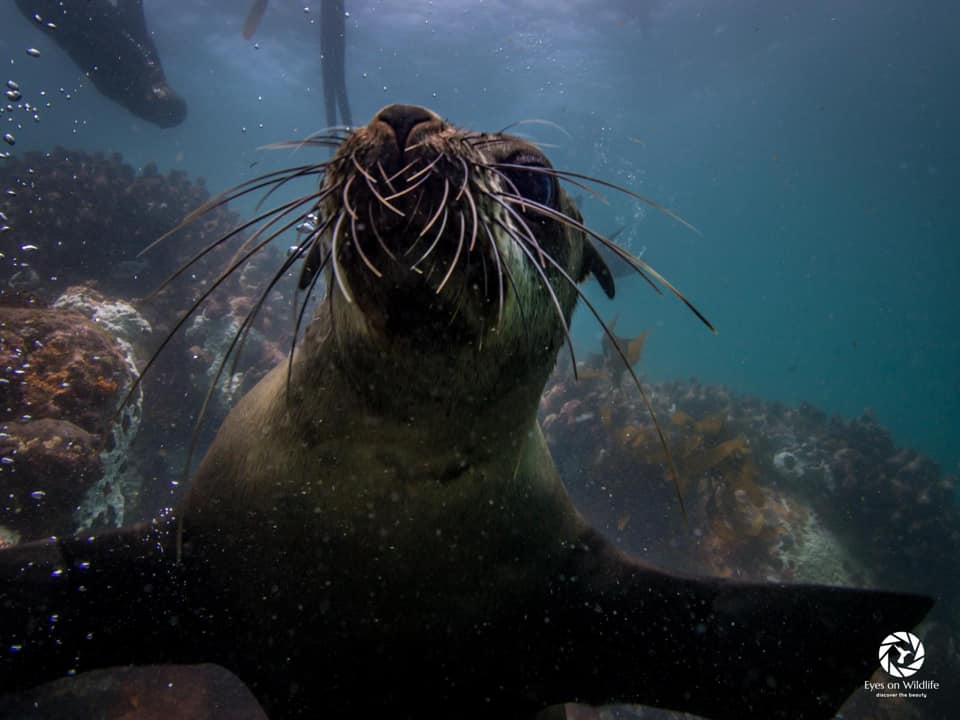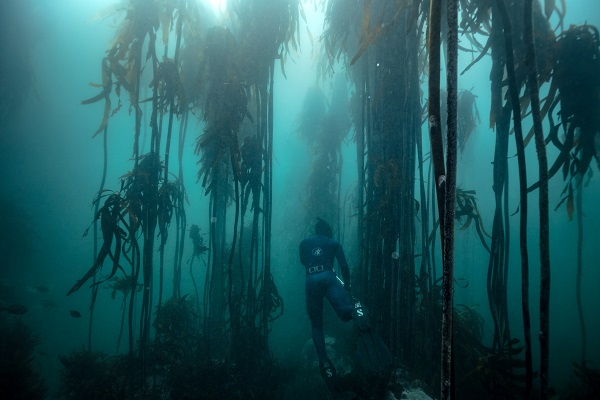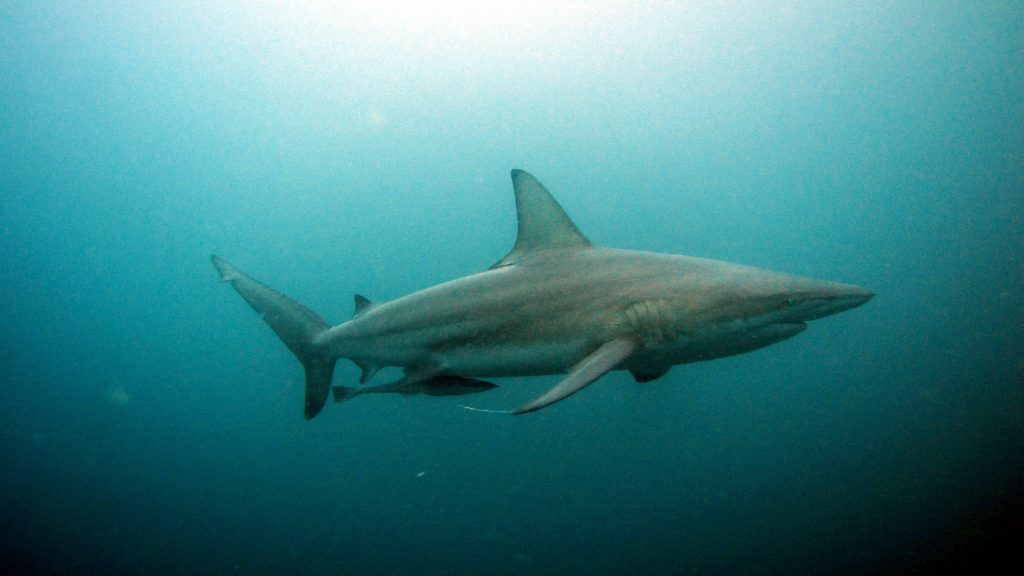Whether you’re a marine biologist, tour guide, wildlife photographer or simply just enjoy being out watching nature, it is very enjoyable to observe and experience new sightings of animals and their behaviors in the wild. To observe is ‘’the action or process of closely observing or monitoring something or someone’’. Wildlife observing is difficult in any case, hence why we have professional field guides in the Kruger or on guided walks. Marine wildlife watching can be even trickier as you are out of your comfort zone and your senses are compromised and takes time to develop.
I have spent thousands of hours throughout my career in and on the water observing wildlife and their environments, and I really think the art of marine wildlife observing is a very underestimated skill. Many inexperienced divers come out of dives having not really seen anything like what more experienced divers are seeing, or unable to get close to the more mobile animals. Sometimes you just get lucky, but like any skill, it takes practice, experience and a whole lot of patience to become an expert wildlife observer.
So, if you’re new to diving and have a thirst for bettering your wildlife observation skills and getting a little closer for longer, here are a few pointers which in my experience have helped me and my students and guests get up close with some of the larger more mobile species in our seas.

Stay calm and stay slow
A relatively obvious one, but like all wildlife watching you don’t want to go charging through the environment disturbing everything before you even have chance to see it. Remember, 99% of the time, the animals are aware of you way before you have spotted them, they are watching for what your body language is saying and your intentions.
In the marine realm this means keeping your body as streamline and controlled as possible. Slow finning, arms tucked in and slow head movements (in my experience I have noticed that even a sudden move of your head is enough to startle the more shy creatures). Try not to break the surface of the water with your fins and make bubbles if you are snorkeling at the surface. When its time to dive down, keep the smooth rhythmic dive motion (head tuck, knees up, roll forward, extend legs, sink) and make sure you are properly weighted so you can slowly but surely glide down to depth without finning and disturbing the surface water too much. If you’re on SCUBA fin slowly and keep your fins away from the substrate (Sand, reef etc.). This will not only make a mess of the water and possibly damage the habitat, but create noise. Remember, noise travels much faster and further underwater, and those vibes are not going to help you get up close with the wildlife.
Calm and slow your breathing. Our breath says a lot about us… breathing fast and quick makes us look like we are high energy high excitement which translates as unpredictable and might look intimidating to a shark or whale. High breathing rate also means increased heart rate, remember, many marine species can sense electronic pulse disturbance through electromagnetic sensory pores. They will feel you coming a mile off.
The calmer and more comfortable we are in the water the more we will ‘fit in’ and see. Having control over your breathing takes practice and can change depending on the stress of a situation, the sea conditions and experience, but this is a really important thing to practice and be aware of all the time when in the water for wildlife watching and just personal awareness and safety. I always describe diving as a ‘meditation’, which if you think about it, is exactly what it is, focusing on our breath and emptying the mind of thoughts focusing only on the here and now (although I usually have an annoying song stuck in my head.)
To achieve this, consciously maintain a calm deep and thorough inhalation and exhalation through the regulator or snorkel, this not only keeps you calm and reduces your disturbance to the environment but also keeps you prepped for your next duck dive down to the bottom, reducing a prolonged breath up if freediving. On SCUBA control your breath so your bubbles are released in a calm gentle manner, not big forceful exhalations, this will scare everything away.

Use and adapt to the environment
It’s always good to remember that when we are in the marine world, we stand out like a rhino in a kennel, and its quite difficult to avoid this, even the best free divers in the fanciest camo suits can’t easily get around this. However, we can mitigate this by being aware and using the environment we are in. This means trying to blend with the habitat by using the bottom profile and the structures around us. We must always be aware of the habitat we are moving through and traversing in, you can’t just go swimming through the water without causing a scene to the locals. Think like you were stalking a rhino on a walk in the Kruger or bird watching from a hide, it’s exactly the same in the sea except we aren’t very well evolved to be so discrete.
If you are on an open reef there is little place to do this, so it helps to get as close to the bottom as possible (without disturbing the substrate). You will often see spearfisherman using this lie and wait technique on dives, allowing the unsuspecting fish unaware of the deadly foreign body lurking and swim right towards them.
Here in the Cape, we are incredibly lucky in the fact that much of our coastal diving is in Kelp forests. You can often get much closer to fish, sharks and seals in the kelp structure than in open water, and this is for two reasons. Firstly, kelp is a brilliant assistance in camouflage and breaking up our big weird human bodies, meaning animals might not realise how big and ugly we are straight away. Secondly the animals are also using this structure as protection and can run for cover or keep a barrier between themselves and us as they like, often making them seemingly more relaxed than being caught out in the open.
By skirting around open sandy patches in the kelp, and keeping still amongst this thick cover of the kelp fronds, softening the ambiguity of your terrestrial form, I find I get much closer and observe the animals more relaxed natural behavior.
It is also important to understand the motion of the ocean. When we dive there is often swell or currents acting on our bodies, but remember the ocean forces are acting on everything else in the environment. The natural world is all about harnessing and saving energy, being as efficient as possible. This is something humans often think they are far to important for, but the ocean is a great leveler. It doesn’t matter if you are Mike Tyson you can’t fight the ocean. Not only will you waste energy and oxygen, but you will be the only thing in the water trying to fight it, making you stand out even more than you already do. If you look around next time your ‘down there’ everything from the kelps to the fish are using the oceans energy to move or keep still efficiently, we must do the same. Go with the flow. When the surge is with you go, when the surge is against you, don’t waste your energy fighting it, feel the motion of the ocean. Basically, think like a fish…

Be conscious of your body language
Imagine walking into the mall and seeing some weird looking animal twice your size you’d never seen before flailing and spluttering around on the floor looking frantic and lost… You’d probably walk right back out pretty quickly, and that’s exactly what inexperienced divers look like. What you are doing with every part of your body counts, both in efficiency and communicating your intentions to everything that is watching you. We can use our bodies to be neutral and look unobtrusive by being small and still or we can use our bodies to be big and bold and intimidating.. all of these interpretations can be used when interacting with animals. When diving with whales, dolphins and large sharks, this body language becomes much more of a two way conversation on a spectrum and can be implemented depending on the opposing body language from the animal. For example, if you want a large shark to show interest and approach you, making yourself look smaller and harmless often helps entice them closer. If said shark starts to act a bit too interested and shows interpreted aggression (increased speed, darting, raised back and lowered pectoral fins) we can them use our body to make us look much bigger (star fish position), make eye contact and use fast sudden movements. Interacting with large animals is a conversation of body language on both sides.
I have applied this knowledge a number of times in my career swimming with large sharks and whales. One example is when I was working in Australia 10 years ago, I was taking some guests on a sunset dive on a late afternoon on the Ningaloo reef. There was a resident 3.5m+ Tiger Shark ‘Tony’ who we often saw cruising around the swing mooring in the evenings when we would be washing the boat down. This particular dive, he decided to join us, he was following from a distance, but getting closer and closer to the back of my group of divers on the reef. After 5 or 6 passes I decided I needed to show him who’s boss (or at least politely ask him) and make sure he didn’t get any closer to my divers. I stopped and gathered the group together against a pinnacle and made retrospectively a somewhat daunting decision to charge the 3.5 meter Tiger shark Tony (using my body language to tell him we are not scared and not tasty). At the time this seemed the most reasonable thing to do…
As Tony turned to make his next pass, I set off and made a beeline straight towards him and him towards me, eye contact and adrenaline running. I stuck my arms out and made myself as big and scary as possible (which if any of you have met me will know is an extraordinarily hard feet). As the distance between us lessened I immediately started to regret the decision and my thoughts turned to the fact I didn’t even have a camera to document my toothy downfall and get some beyond the grave YouTube likes (I didn’t even have YouTube then).. but I was committed now and I had confidence in the animal behavior knowledge I had seen / gathered from other divers in the pub… 6meter…4meters….2meters…. I was staring down the nose of Tony and just as I was about to close my eyes and say my remorseful prayers… Tony suddenly jolted and darted off faster than I could clear my…mask. I let out a huge sigh of relief and returned back to my group. My point being, using our body language can be very effective in communicating where we stand in the ecosystem and our intentions.
The art of observing
So, we’ve made an approach and we have stealthily and skillfully positioned ourselves into trigger position (of the camera) through calm relaxed movement and using the habitat to our advantage, then… we fling our arms out to take a photo with a huge strobe or flash… the subject has scarpered and we go flying back to the surface (if freediving). Yes, you might have got one good photo or 3 seconds of video, but you haven’t gained anything.
Remember, we want to develop the skill of observing, not a second enough to take the photo and return to the surface but a moment in time where you and the animal are in a suspended paradigm as part of the ecosystem. Observation is more than just seeing; it is assimilating further information and knowledge. This doesn’t necessarily mean taking scientific data (although at Cape RADD it often does), but simply experiencing their behavior, anticipating their intentions and reading their body language. This vital time will help develop and improve your next observation, your mistakes, or something else that happened which you can control better next time. When taking the photo, if the animal is skittish, keep all your movements slow, don’t extend your arms too much and try and use natural light as much as possible. Depending on the situation and the animal, sometime direct eye contact will make them fearful, so try and avoid this.
Observation comes down to, the longer we can prolong the moment the more we will experience and learn. This takes lots of practice and experience, but it should be the aim of every wildlife observer not to just snap a photo but to observe and learn. After all that’s why we go searching in this fascinating world.

AND if you take a dorsal shot of a benthic shark, submit your sighting to Cape RADD’s Finspotter.
0 Comments